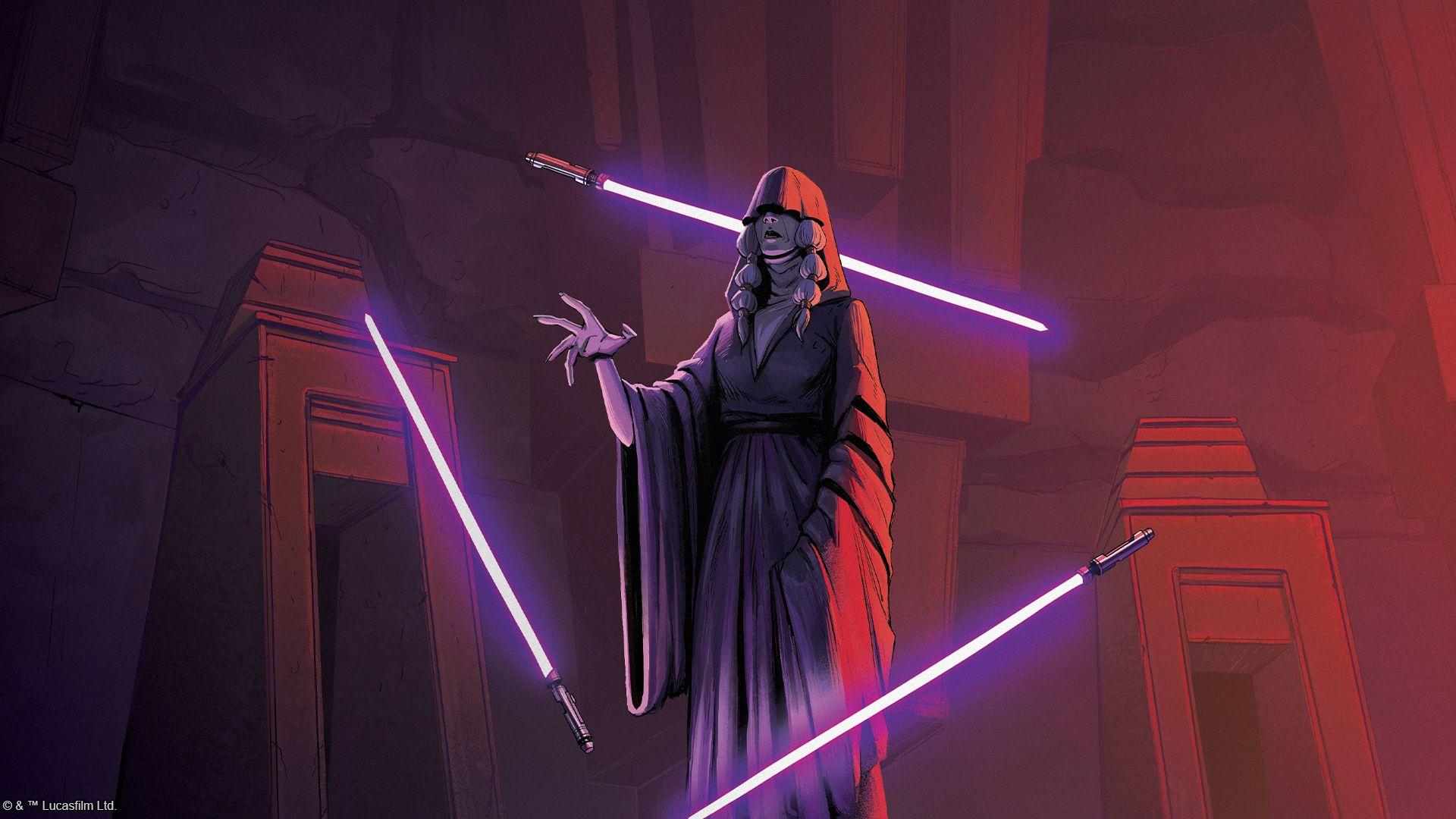Secrets of Sealed
October 30, 2025 | Written by Jayson Lindley
One of the best things about playing a trading card game like Star Wars™: Unlimited is that there are a lot of different ways to play. In all my years of shuffling decks, I've noticed how easy it is for me personally to overlook this. There's invariably a lot of attention focused on the most competitive modes of a given game, but so many of the game's best experiences are found in alternative formats, and the dialogue surrounding them almost never has as much engagement as what's going on at the top tables.
That's part of why we're here today: to spark some good conversation about one of the most underrated ways to play Star Wars: Unlimited. Namely, sealed play.
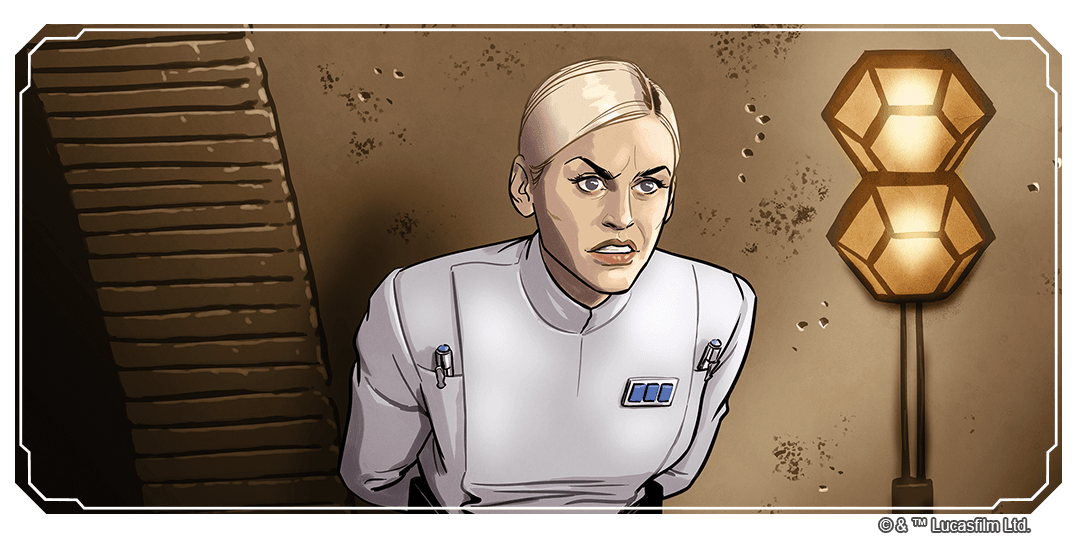
Sealed play begins with players opening up 6 fresh packs of Star Wars: Unlimited cards and building from just those options! It typically involves:
- Deck Size: 30 card minimum
- Player Count: 2+
- Time: 55 minutes
- Games: Best of 3
When I was gearing up for the first set of Star Wars: Unlimited, I actually hadn't played a lot of sealed for other games; but as it would turn out, it was the first format of this game that I ended up playing! I had an incredible opportunity to see the game in the flesh at the Star Wars: Unlimited community celebration, which took place about a month before the game launched. It was a truly wonderful and unforgettable experience that Fantasy Flight Games graciously invited me to join in on. It was there that I made my first ever deck from a sealed pool of 6 packs of Spark of Rebellion. I'll never forget that deck, which was a Sabine Wren (Spark of Rebellion, 14) deck with a pile of Rebel units that I didn't lose with all day. It made me realize that sealed play had some really interesting implications, despite having a lot in common with draft play on the surface.
Those implications are worth talking about before we get into the finer points of how to improve your sealed play experience. If you're with me so far—and trust me, you don't need to have any prior experience with Star Wars: Unlimited for this to be relevant for you—then let's dive into some Secrets of Sealed!
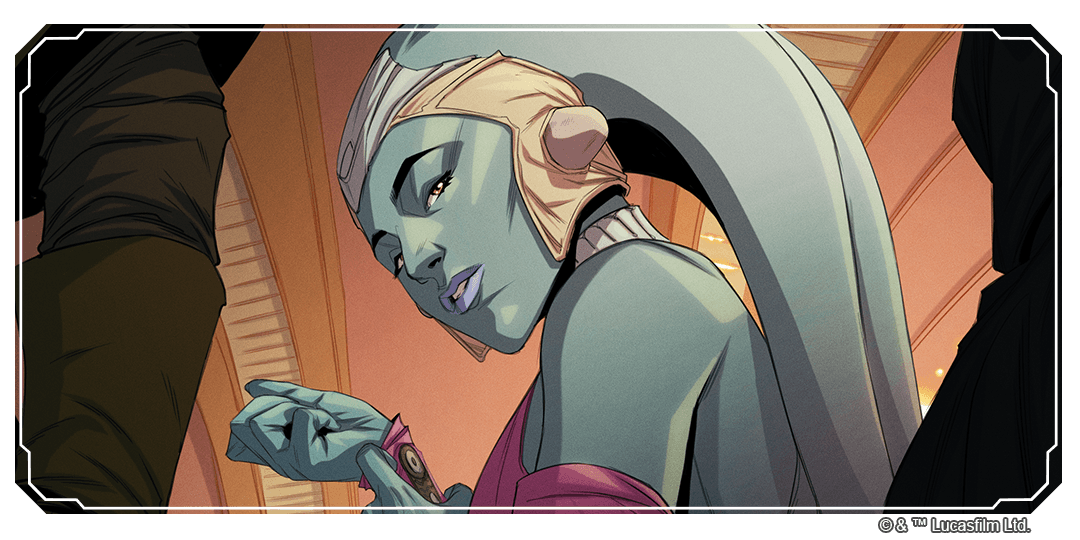
What Separates Sealed
So! What is it about this format that makes it so special and surprised me so much when I came in with almost no expectations for it? I think it boils down to three things.
Sealed Emphasizes Fundamentals
Because you're working with such a limited card pool, the best plays in sealed usually are less about coming up with a crazy combo and more about playing the best straight-ahead game you can.
- For new players, this makes sealed play a great environment to learn the ropes.
- For veterans, sealed play can be a refreshing return to the roots of what makes the game great.
Sealed Tests Both Deckbuilding and Deck Piloting
There's no way around it; you're going to have to build and play a deck in the same event! While that might sound intimidating, the best part is that everyone else is working under the same limitation.
- For new players, sealed play evens the playing field and lets you experience multiple aspects of the game's appeal at once.
- For veterans, sealed play is a great mental exercise that keeps your building chops up to speed and tests your knowledge of the set.
Set Knowledge Aids Success
So you've got a deck with a solid foundation and you're feeling good about making the right calls in the game. What's the difference-maker now? Well, the players who do well at the end of the day are going to be the ones who did those things well and made the right calls about how to approach that set's particular play space.
- For new players, this means just a little research and pre-event planning can give you a major edge against the unprepared.
- For veterans, being tuned in to the pulse of the game and the community's evaluation of the set in the prerelease period will likely be rewarded.
These are the particular axes where sealed play differentiates itself greatly from other formats, and as you're about to see, watching these factors play out as you get your deck together is a ton of fun. Let's explore how to efficiently and effectively get your stack together as you crack open those packs!
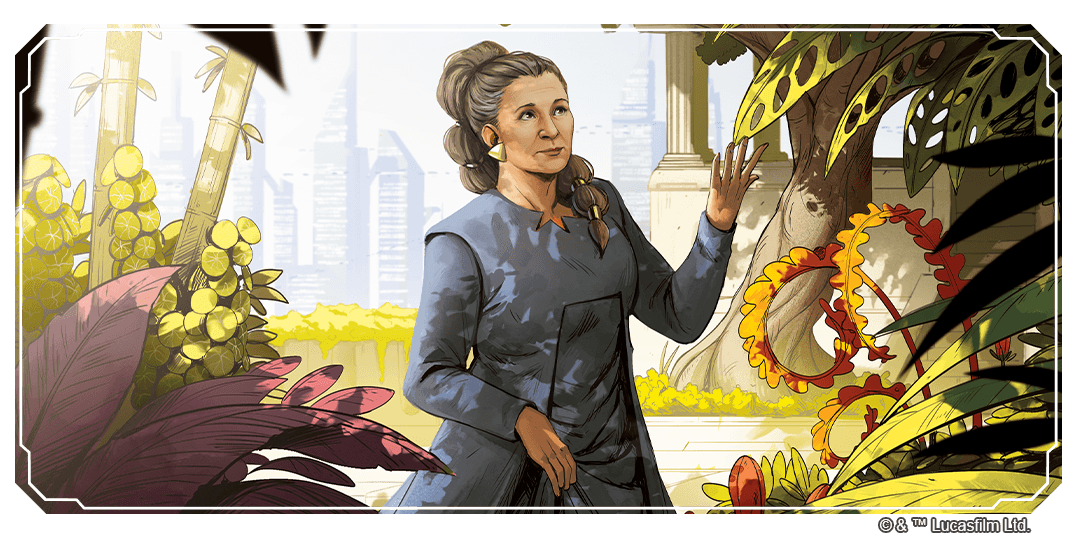
Starting With Sealed
Here's the basic step-by-step process I use when I'm getting my sealed decks together on event day:
- Organize my cards into stacks
- Identify my best stacks
- Use my available leaders and best stacks to guess what my optimal deck is
- Build my deck
- Evaluate and pivot if necessary
Let's break those steps down a little bit further so you can really get a sense of how we get this done!
Step 1: Organize your cards into stacks: You need to start the process by getting your cards divided up. This helps you see at a glance what you're working with- 6 packs isn't a ton of cards, but it's enough to where you'll want to get your bearings. My preferred method is to set aside my leaders and bases and deal the rest into a 5x3 grid of cards, with the 5 columns being Vigilance, Command, Aggression, Cunning, and Neutral, and the 3 rows being Villainy, Heroism, and Neutral.
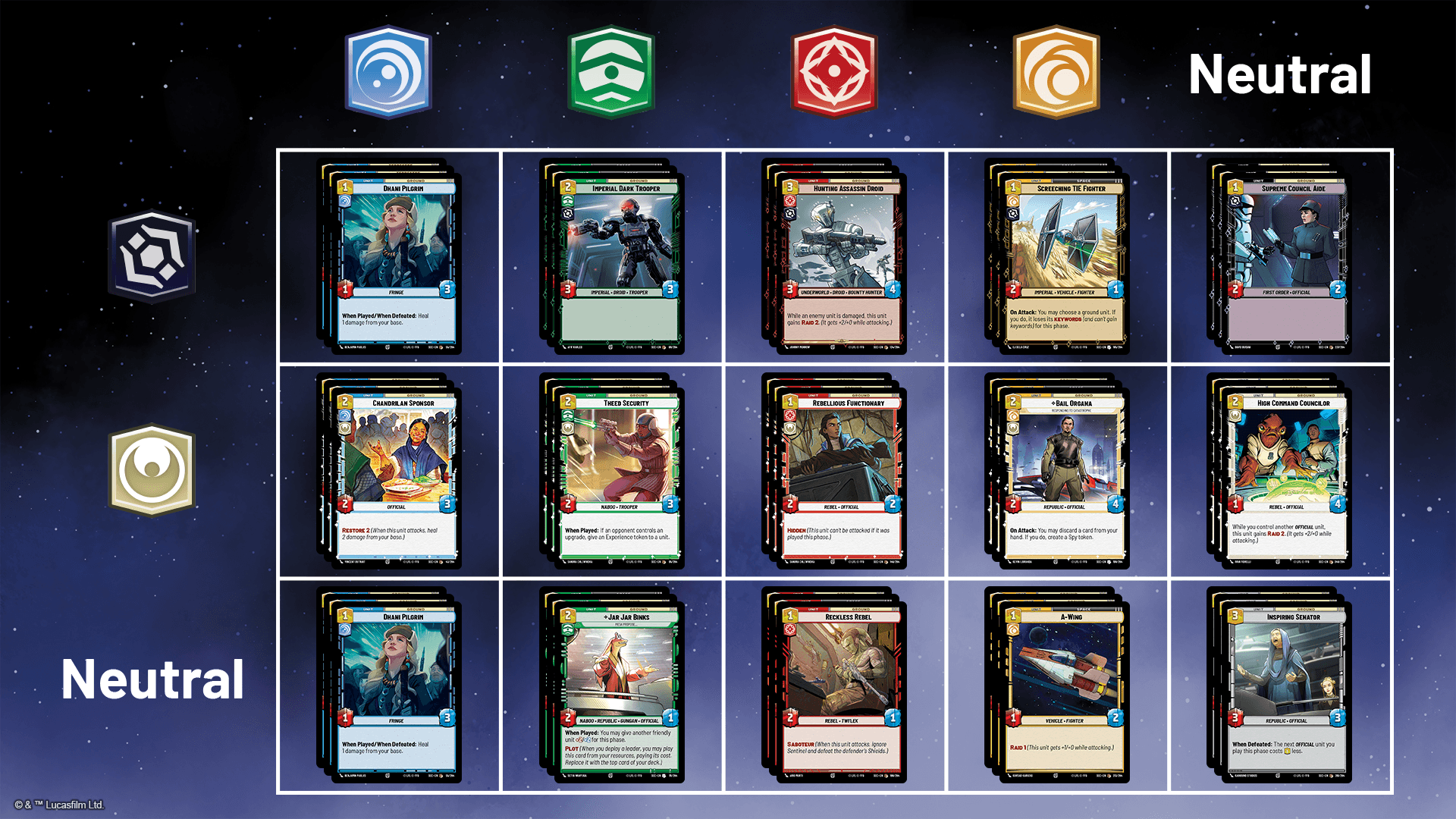
Step 2: Identify your best stacks: This benefits, of course, from time and experience, but you can get started evaluating which parts of your card pool are most viable just by doing some counting! Take a note of which of the stacks have a lot of cards in them. In particular, you'll want to see which stacks with multiple aspects in them are looking thick, because in general a two-aspect card is going to be a little stronger than a card with only one aspect, so the stacks with more aspect icons are likely to hold key pieces in them. What you're really looking for as you flag stacks for potential is plenty of units spread across the cost range up until about 6- or 7-cost units at the high end.
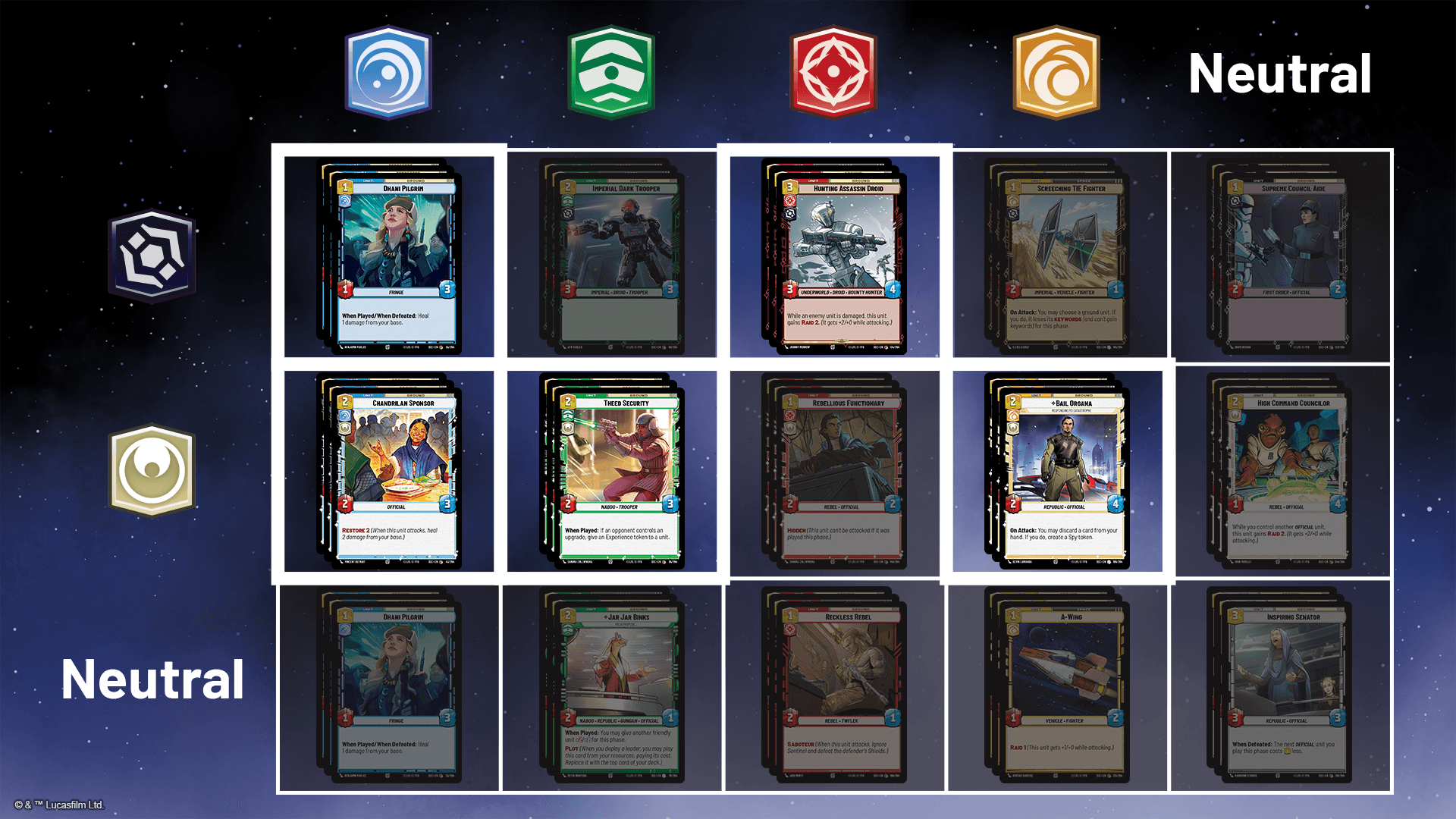
Step 3: Use your available leaders and best stacks to guess what your optimal deck is: You're going to have 6 Leaders to choose from, and we've already got our eyes on certain aspects that have potential. If our Vigilance-Heroism and Command-Heroism stacks are looking pretty good, we're going to want to make sure we have a leader available in one of those aspect combinations. Furthermore, you should consider your own personal preferences as you determine what's “optimal” for you—we're here to have fun, so when in doubt, we should play aspects and characters that we personally like! And remember, your choice of leader and base gives you access to so many stacks! Our example here is going to be a Leia Organa (Secrets of Power, 4) deck using the Senate Rotunda (Secrets of Power, 22) base, which mean we get to use the Vigilance-Heroism, Command-Heroism, Vigilance, Command, Heroism, and Neutral stacks.
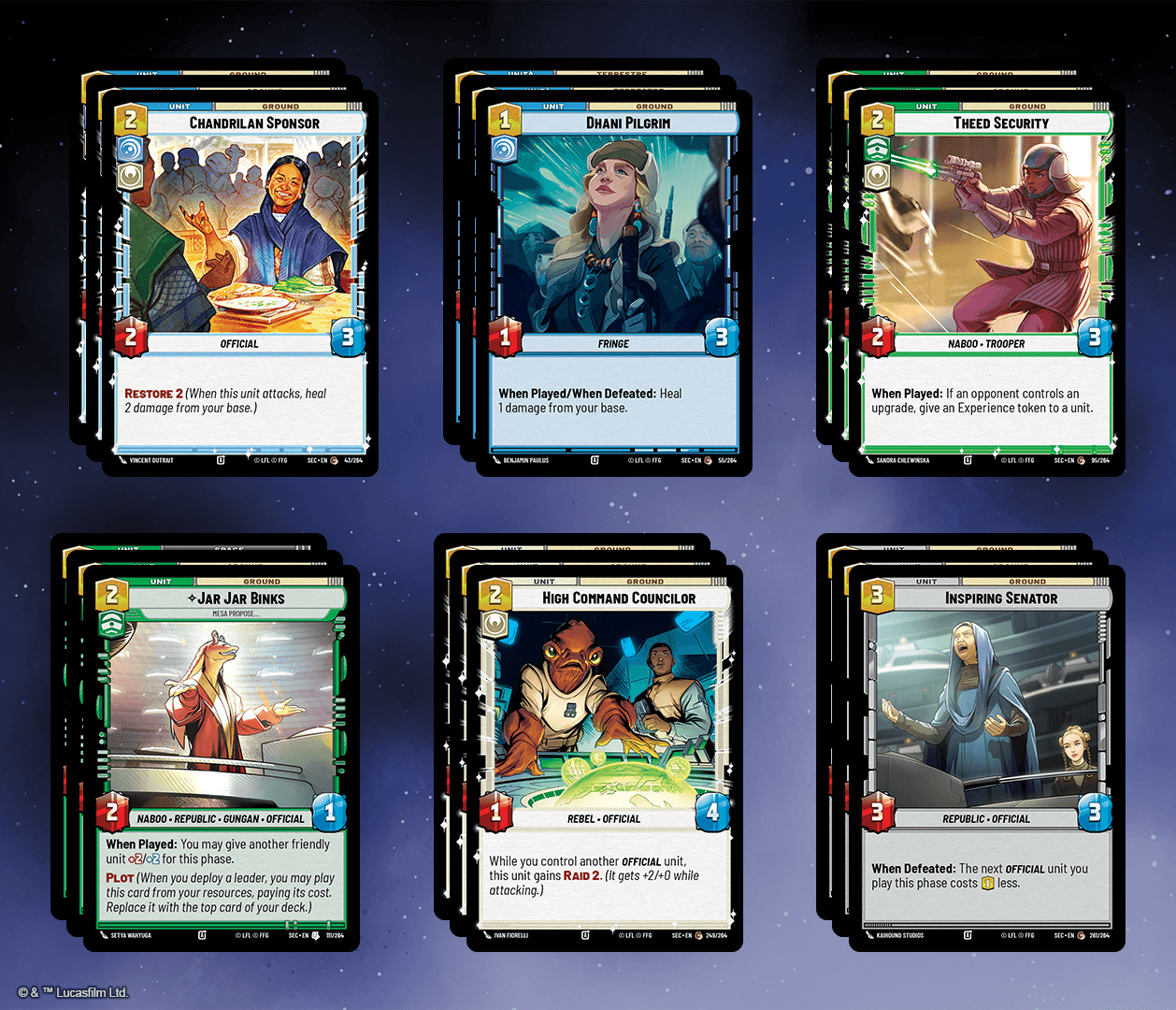
Step 4: Build your deck: Now for the really fun stuff: take 5 of those stacks (everything except the Neutral cards) and chunk them together, and then go back in and organize them by cost. After that, count them up; if you've got more than 30 cards, you'll need to cut some, because it's rarely ever a good idea to go above minimum deck size. If you're below 30, bring in some of those Neutral cards to get up there. At all points where you need to make decisions, I would suggest prioritizing units, especially ones in the 3- to 5-cost range that form the backbone of the always-crucial midgame.
Step 5: Evaluate and pivot if necessary: Here's the deal: sometimes, you have to be willing to turn around if you're headed down the wrong road. In particular, your chosen deck may not be worth sticking with if you're short on viable first turn plays and space units. I like to have no fewer than 7 of each in a 30-card sealed deck. You also need to make sure your unit count is solid on the off chance that you pulled a lot of events in your packs; I like to have between 24 and 25 units in my sealed decks.
These five steps are, of course, just one approach, and rules are made to be broken! But my guidelines here are based on the idea that sealed play is best tackled as an exercise in fundamentals. We want plenty of units because they're the lifeblood of almost every Star Wars: Unlimited deck, letting you both answer enemy threats and pursue your own win condition. We want plenty of early plays because we likely won't be able to recover if we're stuck with a bunch of expensive cards in our hand. We want plenty of space units because, while they're less prevalent than ground units, we could absolutely lose the game if we don't have options available for both arenas. You want to cover the basics so that all your choices have room to shine.
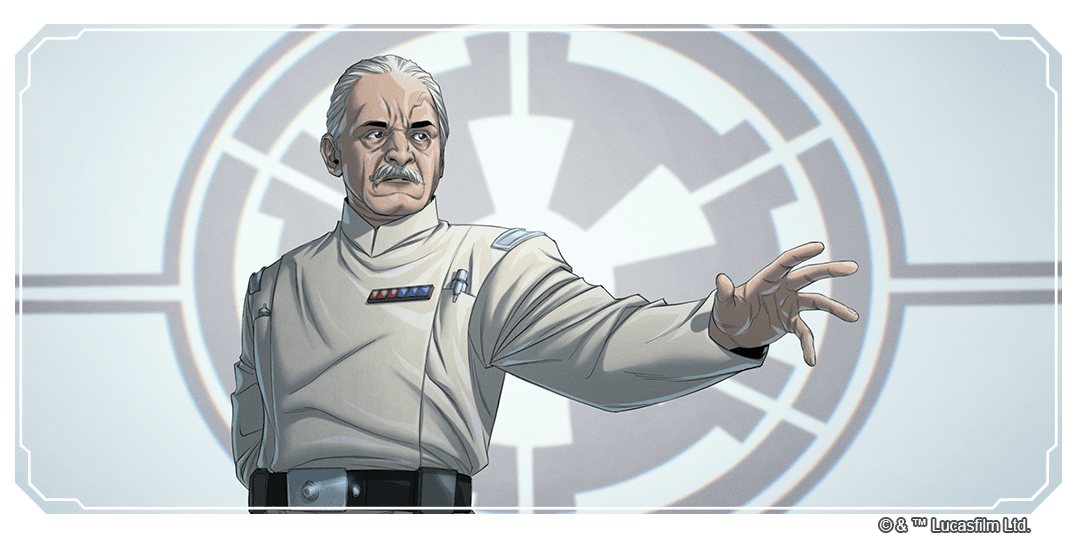
A Bird's-Eye View
While the basics of getting a sealed play deck together are always applicable, if you really want to elevate your game, one of the best things you can do is gain some upper-level knowledge of the particulars of the set you're going to be using. Every Star Wars: Unlimited set has its own little personality, a full-blown internal ecosystem where all the different pieces of the set interact with each other when they're isolated to the single-set environment. This applies to draft play too, but it's especially noticeable in sealed; prerelease events for Shadows of the Galaxy felt so different compared to the ones for Spark of Rebellion, because the design principles of the sets just had a totally different texture.
This is an amazing thing! It means that every new set release is an opportunity to experience the game in a whole new way. That said, it does also mean that doing your best in limited formats requires you to do a little bit of homework ahead of time. You're just going to have a better day if you understand the environment you're going to be working in, so let's give that a shot now! I'm going to walk you through a very basic analysis of the sealed environment for the upcoming set, Secrets of Power. We'll walk through the same things I'd recommend walking through with any new set if I was playing limited:
- Set mechanics and their implications
- Leader trends to be aware of
- Notable Common cards for each aspect
All good things to note! We'll start with those set mechanics, as they have implications for our other two observation points.
Set Mechanics and Their Implications
The major set mechanics for Secrets of Power are Plot and disclosure, both of which are pretty informative for us in terms of how the set will play. Plot takes a moment in Star Wars: Unlimited that is already pretty game-defining—leader deployment—and adds even more juice by letting you pile on additional actions from your resource row. This means that you can expect your opponent's leader turn to be a real haymaker, and therefore you're going to want to match that energy with a high-impact deployment of your own. You can think of it as an arms race; because your opponent will have access to Plot, you need to give it extra consideration yourself, lest you find yourself unable to fight fire with fire.
Meanwhile, disclosure comes with its own wrinkles. It means you could end up in many situations where a card's full efficiency will be gated behind giving your opponent access to information about your hand. To me, that means giving a little more weight to cards that don't need to catch my opponent off-guard to make an impact. Straightforward power plays are going to be the name of the game.
Leader Trends to be Aware of
The leaders in Secrets of Power are fairly straightforward, with solid choices spread decently across the aspects. I would note that the aforementioned Leia Organa leader and Colonel Yularen (Secrets of Power, 6) seem like they might be particularly reliable in sealed play, with their on-rate stats and straightforward abilities, whereas the Cunning-Villainy common leader, Sly Moore (Secrets of Power, 14), has a pretty conditional leader ability that you might have a tough time getting to use in a limited format. The Cunning-Villainy card pool has lots of juicy options, but you might want to consider all your options for getting access to them!
Notable Common Cards for Each Aspect
This is an important subject for each new set because having a grasp on what Common cards in the set have strong fundamentals will help you in your decision-making as you're narrowing down what deck to play. Commons are intended to have broad play application in limited formats, but that can be accomplished in a number of different ways and have different levels of efficacy. Everyone's metric for success here is going to be different. Me? I like efficient, always-relevant effects and sweet, sweet statlines. You just can't go wrong with tons of power and health, especially in limited play where fundamentals have a ton of relevance. Looking specifically at Secrets of Power, here's some Commons that I've identified as being strong choices in almost any sealed deck:
Vigilance
- Death Trooper (a classic, always good)
- Dogmatic Shock Squad (leader protection via Plot)
- Chandrilan Sponsor (super solid Restore keyword)
- Populist Champion (great stats)
- Jade Squadron Patrol (space Sentinel units are always important)
- Bardottan Ornithopter (terrific card draw)
- Rotunda Senate Guards (a workhorse Sentinel)
- Armor of Fortune (leader protection via Plot)
Command
- Imperial Dark Trooper (excellent stats, like a Battlefield Marine for Villainy)
- Beloved Orator (multiple units for one card is usually good in limited)
- Dresselian Commandos (a good swing card for your leader deployment)
- Diplomatic Envoy (high upside access to Ambush)
- Daro Commando (reliable value)
- Consular's Cruiser (space Sentinel units are always important)
Aggression
- Imperial Occupier (multiple units for one card is usually good in limited)
- Enforcer Squadron (an aggressive space unit can sometimes win the game outright)
- Inner Rim Coalition (high ceiling)
- Warrior of Clan Ordo (negligible downside in exchange for great stats)
- Republic War Walker (a solid closer, which is hard to find in sealed!)
Cunning
- ISB Agent (damage from hand is good to have around)
- Screeching TIE Fighter (can negate nasty Sentinel or Restore on the enemy side)
- Lurking Snub Fighter (a nice swing card for deployment that can exhaust a key threat)
- Trade Federation Delegates (multiple units for one card is usually good in limited)
- Bravo Squadron Fighter (easy access to Saboteur)
- Regulations Bureaucrat (resource disruption can be powerful if left unanswered)
- Beguile (solid tech card combining unit bounce and hand knowledge)
Villainy
- Viper Probe Droid (another classic staple)
- Contempt For Culture (surprisingly potent combo of damage from hand and a unit)
Heroism
- Remote Escort Tank (on-rate leader protection)
- Grassroots Resistance (two solid, always relevant effects in one)
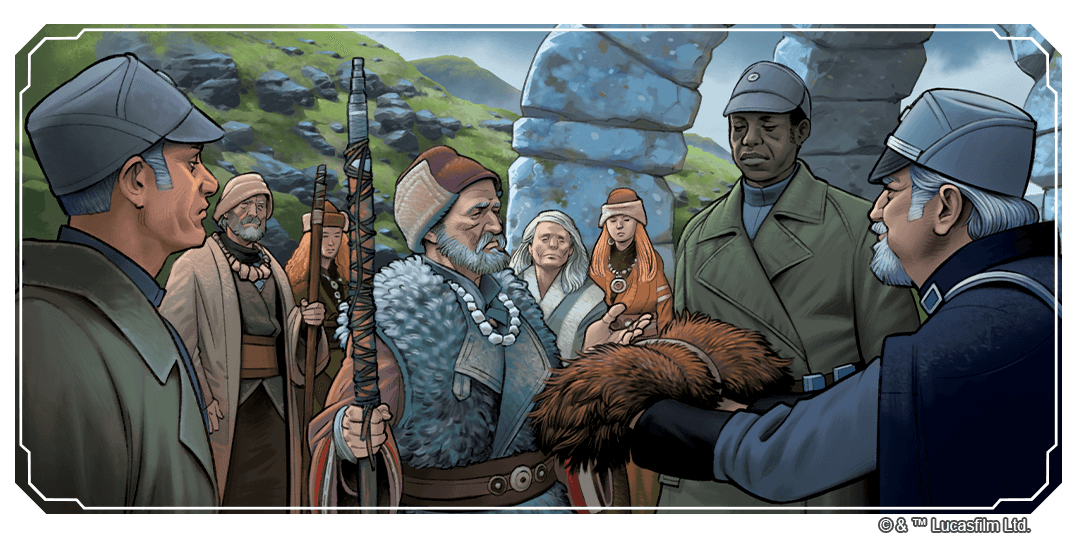
Signed, Sealed, Delivered
Some of the most exciting events you can go to in Star Wars: Unlimited are Prerelease events, which feature the sealed format! That means you can put these tips into practice at a Prerelease near you when Secrets of Power launches this November.
I hope that your Prerelease experience benefits from the secrets we've shared today! Now go out there, build some great sealed decks, and have as much fun as you can playing the always exciting, ever-evolving Star Wars: Unlimited.
Share This Post



